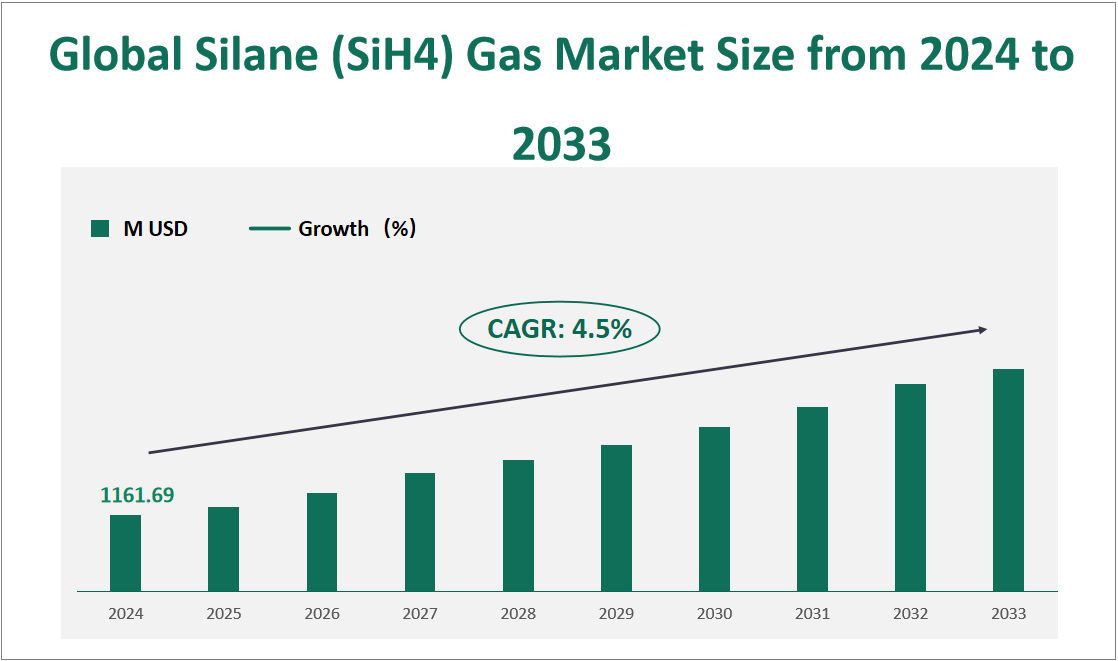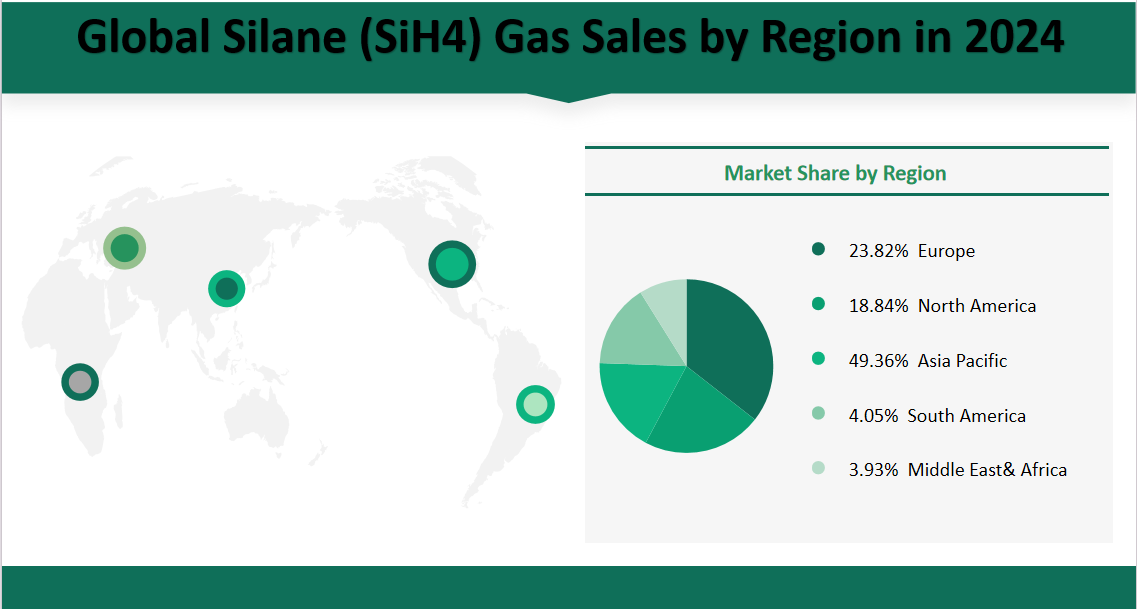1 Global Silane (SiH4) Gas Market Outlook
The global Silane (SiH4) Gas market is projected to exhibit substantial growth in the coming years, with a CAGR of 4.5% from 2024 to 2033, reaching a total market size of $1161.69 million USD in 2024. Silane (SiH4) Gas, also known as viral Silane (SiH4) Gas or phagotherapy, is a therapeutic approach that utilizes bacteriophages, which are viruses that specifically target and kill bacteria. These viruses are nature’s way of controlling bacterial populations and have the unique ability to inject their genetic material into bacteria, using the host’s machinery to replicate themselves, ultimately leading to the destruction of the bacterial host. This makes Silane (SiH4) Gas a promising alternative to traditional antibiotics, especially in the face of growing antibiotic resistance. Silane (SiH4) Gas has a wide range of applications, including human health, animal health, agriculture, and the food industry. In human medicine, it can be used to treat infections that are resistant to antibiotics, such as MRSA. In animal health, phages can help control diseases in livestock and poultry. In agriculture, they can stimulate crop rhizosphere immunity and control soil-borne diseases. In the food industry, Silane (SiH4) Gas can prevent product decay and the spread of bacterial diseases, ensuring safer food production and handling environments.
Figure Global Silane (SiH4) Gas Market Size and Growth Rate (2024-2033)

2 Silane (SiH4) Gas Market Growth Drivers and Constraints
The growth of the Silane (SiH4) Gas market is driven by several key factors. Firstly, the increasing prevalence of antibiotic-resistant infections has led to a renaissance in phage research. With the limited discovery and development of new antibiotics, Silane (SiH4) Gas has emerged as a potential alternative for treating multidrug-resistant bacterial infections. The Centers for Disease Control and Prevention (CDC) reported that in 2019, approximately 2 million people in the United States contracted an antibiotic-resistant infection, with at least 23,000 people dying each year. The World Health Organization also noted that over 490,000 persons worldwide were infected with multidrug-resistant tuberculosis in 2016. Secondly, the growing understanding of the human microbiome and its role in health and disease has opened new avenues for Silane (SiH4) Gas. Phages can be used to modulate the microbiome, addressing both infectious and non-infectious diseases. Lastly, the phage therapeutics market is active in investment and research, with increasing financing and cooperative transactions. For example, Adaptive Phage Therapeutics (APT) closed a $40.75 million Series B investment round in 2021, and Locus Biosciences secured up to $25 million in financing from Hercules Capital, Inc. to develop more precise engineered phage therapies.
However, there are also limiting factors that may hinder the growth of the Silane (SiH4) Gas market. One of the main challenges is the presence of alternative treatments for antimicrobial-resistant infections. Many bacterial infections can still be treated with antibacterial agents and prevented by vaccinations, and an increasing number of drugs are entering the market for the treatment of antimicrobial-resistant infections. Additionally, regulatory policies and standards for Silane (SiH4) Gas are not yet perfect. The production and application of phages lack quality control standards and safety evaluation systems, and there is no clear standard for phage isolation and purification, which makes the efficacy of isolated phage preparations variable.
3 Silane (SiH4) Gas Market Innovations and M&A Activities
The Silane (SiH4) Gas market is witnessing significant technological innovations and corporate activities. Technological advancements in DNA sequencing and artificial intelligence (AI) have accelerated phage screening and therapeutic construction. Companies like AmpliPhi Biosciences (APHB) have sequenced phages to quickly find and identify the required phages, while startups like APT have established PhageBank, a gene database for storing phages. The use of synthetic biology and gene editing tools has also expanded the scope of phage action, enabling more precise therapy. Engineered phages based on CRISPR, artificial synthesis, and other technologies can effectively solve problems of bacterial tolerance and phage self-toxicity.
On the corporate front, there have been notable mergers, acquisitions, and expansions. For instance, Locus Biosciences acquired EpiBiome’s high-throughput bacteriophage discovery platform in 2018 to develop products to treat antibiotic-resistant bacterial infections and precisely edit the microbiome. Phagelux AgriHealth announced multiple agricultural commercial collaborations in 2020, including an exclusive European sale, marketing, and product development collaboration with DCM for its AgriPhage line of biopesticides. Proteon Pharmaceuticals secured an investment of €21 million in 2021 to accelerate the commercialization of its bacteriophage products, aiming to reduce the reliance on antibiotics in aquaculture and livestock farming. These activities indicate a vibrant and growing market, with companies actively seeking to expand their capabilities and market share through strategic partnerships and investments.
4 Global Silane (SiH4) Gas Market Analysis by Type
In 2024, the global Silane (SiH4) Gas market is forecasted to generate a total revenue of $1,161.69 million. The market share distribution by type is as follows: Silane (SiH4) Gas with purity less than 5N (Purity < 5N) is expected to contribute $420.56 million, representing 36.20% of the total market revenue. Meanwhile, Silane (SiH4) Gas with purity of 5N or higher (Purity ≥ 5N) is projected to account for $741.13 million, capturing 63.80% of the market revenue.
Table Global Silane (SiH4) Gas Market Size and Share by Type in 2024
Type | Market Size in 2024 (M USD) | Market Share in 2024 (%) |
|---|---|---|
Purity < 5N | 420.56 | 36.20% |
Purity ≥ 5N | 741.13 | 63.80% |
5 Global Silane (SiH4) Gas Market Analysis by Application
In 2024, the global Silane (SiH4) Gas market is forecasted to reach a total sales volume of 47,246 tons. The market share distribution by application is as follows: the Semiconductor sector is expected to account for 19,151 tons, representing 40.53% of the total market; the Displays industry is projected to contribute 15,676 tons, holding 33.18% of the market; the Photovoltaics sector is anticipated to reach 6,891 tons, capturing 14.59% of the market; and Other applications are expected to total 5,529 tons, making up 11.70% of the market..
Table Global Silane (SiH4) Gas Sales and Share by Application in 2024
Application | Sales in 2024 (Tons) | Market Share in 2024 (%) |
|---|---|---|
Semiconductor | 19151 | 40.53% |
Displays | 15675 | 33.18% |
Photovoltaics | 6891 | 14.59% |
Others | 5529 | 11.70% |
6 Global Silane (SiH4) Gas Market Analysis by Region
In 2024, the global Silane (SiH4) Gas market is forecasted to generate a total revenue of $1,161.69 million. The market share distribution by region is as follows: Asia-Pacific is expected to lead with a revenue of $573.36 million, capturing 49.36% of the global market. Europe is projected to contribute $276.70 million, holding 23.82% of the market. North America is anticipated to generate $218.90 million, representing 18.84% of the market. South America is expected to account for $47.03 million, or 4.05% of the market. Lastly, the Middle East and Africa are forecasted to contribute $45.69 million, making up 3.93% of the global market.
Figure Global Silane (SiH4) Gas Market Share by Region in 2024

7 Top 3 Companies of Global Silane (SiH4) Gas Market
7.1 Air Liquide
Company Introduction and Business Overview:
Air Liquide is a leading global supplier of industrial gases, with a strong presence in the Silane (SiH4) Gas market. Established in 1902, the company is headquartered in France and operates in over 80 countries worldwide. Air Liquide is renowned for its high-quality products and innovative solutions, catering to a wide range of industries, including electronics, healthcare, and manufacturing. The company’s commitment to sustainability and continuous improvement has solidified its position as a market leader.
Products Offered:
Air Liquide offers a comprehensive range of Silane (SiH4) Gas products, primarily focusing on high-purity gases for industrial applications. Their product portfolio includes both Purity < 5N and Purity ≥ 5N Silane (SiH4) Gas, catering to diverse customer needs. These gases are essential for various applications, including semiconductor manufacturing, flat panel displays, and photovoltaic cells. Air Liquide’s products are known for their high quality and reliability, making them a preferred choice for many industrial users.
Sales Revenue in the Latest Year:
In the latest year, Air Liquide reported a revenue of approximately $138.08 million from its Silane (SiH4) Gas sales. This figure reflects the company’s strong market position and its ability to deliver high-quality products that meet the evolving needs of the semiconductor and electronics industries. Air Liquide’s continued investment in research and development ensures that its products remain at the forefront of technological innovation, further solidifying its leadership in the market.
7.2 Linde plc
Company Introduction and Business Overview:
Linde plc is a global leader in the production and distribution of industrial gases. Formed through the merger of Linde AG and Praxair, Linde plc is headquartered in Ireland and operates worldwide. The company is known for its extensive product portfolio and innovative solutions, serving various industries such as healthcare, electronics, and manufacturing. Linde plc’s commitment to sustainability and customer satisfaction has helped it maintain a strong market presence and drive industry growth.
Products Offered:
Linde plc offers a wide range of Silane (SiH4) Gas products, including both industrial-grade and high-purity gases. Their product offerings cater to various applications, from semiconductor manufacturing to flat panel displays and photovoltaic cells. Linde plc’s high-purity Silane (SiH4) Gas is particularly sought after for its reliability and performance in demanding industrial processes. The company’s extensive research and development efforts ensure that its products meet the highest standards of quality and purity.
Sales Revenue in the Latest Year:
In the latest year, Linde plc reported a revenue of approximately $131.63 million from its Silane (SiH4) Gas sales. This revenue figure underscores Linde plc’s strong market position and its ability to deliver advanced, high-performance products. Linde plc’s continued focus on innovation and customer satisfaction ensures that it remains a key player in the global Silane (SiH4) Gas market.
7.3 REC Silicon
Company Introduction and Business Overview:
REC Silicon is a leading producer of advanced silicon materials, supplying high-purity polysilicon and silicon gases to the solar and electronics industries worldwide. Established in 1996, the company is headquartered in the United States and operates globally. REC Silicon is known for its innovative solutions and high-quality products, which are essential for the production of semiconductors and photovoltaic cells. The company’s commitment to sustainability and continuous improvement has helped it maintain a strong market presence and drive industry growth.
Products Offered:
REC Silicon offers a range of Silane (SiH4) Gas products, including high-purity gases for semiconductor manufacturing and photovoltaic applications. Their products are known for their high quality and reliability, making them a preferred choice for many industrial users. REC Silicon’s innovative solutions and commitment to sustainability ensure that its products meet the highest standards of quality and performance.
Sales Revenue in the Latest Year:
In the latest year, REC Silicon reported a revenue of approximately $103.67 million from its Silane (SiH4) Gas sales. This revenue figure highlights REC Silicon’s strong market position and its ability to deliver high-quality, reliable products. The company’s continued investment in research and development ensures that its products remain at the forefront of technological innovation, further solidifying its leadership in the market

